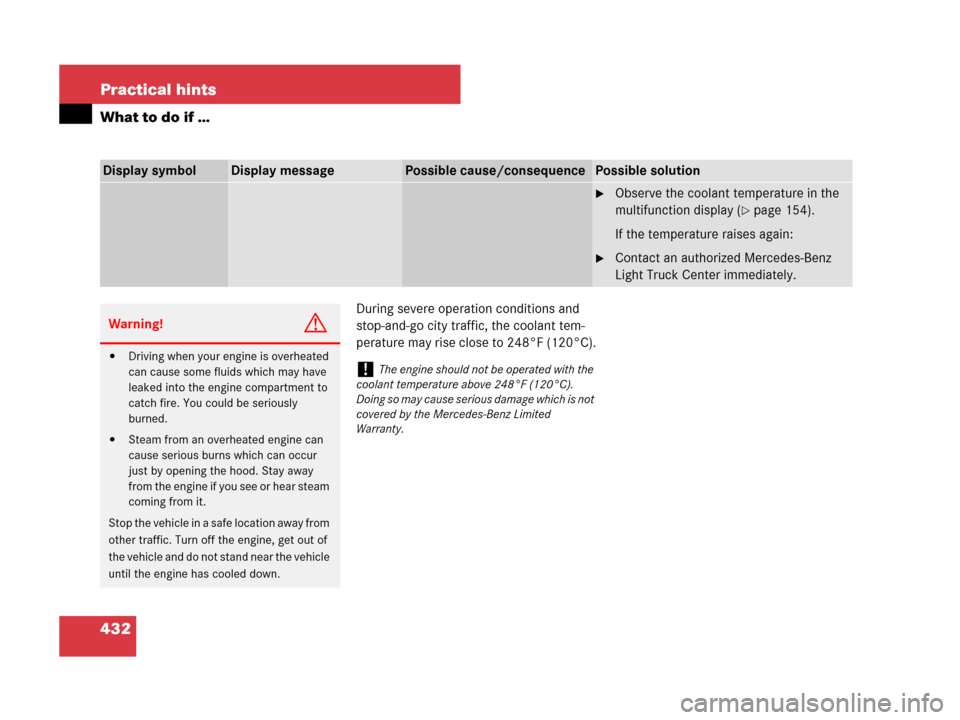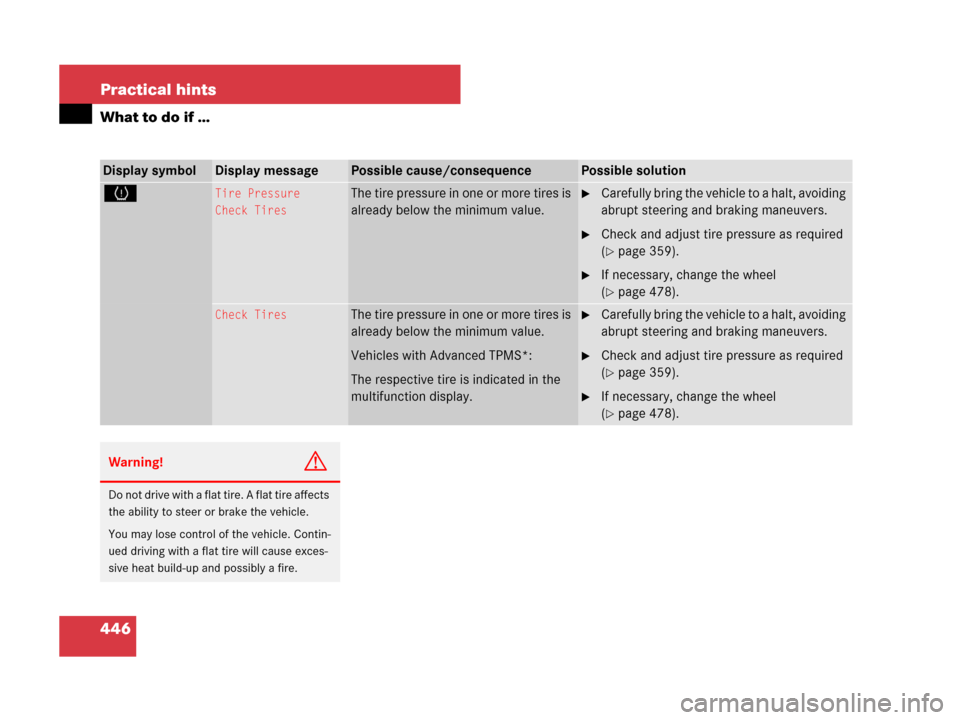Page 426 of 561

425 Practical hints
What to do if …
Display messagePossible cause/consequencePossible solution
Check tires,
then restart
Run Flat Indicator.There was a warning message about a
loss in the tire inflation pressure and
the Run Flat Indicator has not been
restarted yet.�Make sure that the correct tire inflation pressure is set
for each tire.
�Then restart the Run Flat Indicator (�page 361).
Run Flat Indicator
InoperativeThe Run Flat Indicator is malfunction-
ing.�Have the Run Flat Indicator checked by an authorized
Mercedes-Benz Light Truck Center.
Tire Pressure
Check TiresThe Run Flat Indicator indicates that
the pressure is too low in one or more
tires.�Carefully bring the vehicle to a halt, avoiding abrupt
steering and braking maneuvers. Observe the traffic
situation around you.
�Check and adjust tire inflation pressure as required
(
�page 359).
�If necessary, replace the wheel (�page 478).
�Reactivate the Run Flat Indicator after adjusting the tire
inflation pressure values (
�page 361).
Tire pressure
displayed after
driving for
a few minutes.Vehicles with Advanced TPMS*:
The tire inflation pressure is being
checked.�Drive the vehicle for a few minutes.
Page 431 of 561
430 Practical hints
What to do if …
Display symbolDisplay messagePossible cause/consequencePossible solution
;(USA only)
3(Canada only)
Check
Brake Fluid LevelThere is insufficient brake fluid
in the reservoir.�Risk of accident! Stop the vehicle in a
safe location or as soon at is safe to do
so.
�Apply the parking brake (�page 65).
�Contact an authorized Mercedes-Benz
Light Truck Center. Do not add brake
fluid! This will not solve the problem.
Warning!G
Driving with the message Check Brake
Fluid Level
displayed can result in an
accident. Have your brake system checked
immediately. Do not add brake fluid before
checking the brake system. Overfilling the
brake fluid reservoir can result in spilling
brake fluid on hot engine parts and the
brake fluid catching fire. You could be
seriously burned.
!If you find that the brake fluid in the brake
fluid reservoir has fallen to the minimum mark or
below, have the brake system checked for brake
pad thickness and leaks.
Page 433 of 561

432 Practical hints
What to do if …
During severe operation conditions and
stop-and-go city traffic, the coolant tem-
perature may rise close to 248°F (120°C).
Display symbolDisplay messagePossible cause/consequencePossible solution
�Observe the coolant temperature in the
multifunction display (
�page 154).
If the temperature raises again:
�Contact an authorized Mercedes-Benz
Light Truck Center immediately.
Warning!G
�Driving when your engine is overheated
can cause some fluids which may have
leaked into the engine compartment to
catch fire. You could be seriously
burned.
�Steam from an overheated engine can
cause serious burns which can occur
just by opening the hood. Stay away
from the engine if you see or hear steam
coming from it.
Stop the vehicle in a safe location away from
other traffic. Turn off the engine, get out of
the vehicle and do not stand near the vehicle
until the engine has cooled down.
!The engine should not be operated with the
coolant temperature above 248°F (120°C).
Doing so may cause serious damage which is not
covered by the Mercedes-Benz Limited
Warranty.
Page 434 of 561
433 Practical hints
What to do if …
Display symbolDisplay messagePossible cause/consequencePossible solution
B Top Up Coolant
See Operator’s ManualThe coolant level is too low.�Add coolant (�page 345).
�If you have to add coolant frequently,
have the cooling system checked by an
authorized Mercedes-Benz Light Truck
Center.
Warning!G
Do not spill antifreeze on hot engine parts.
Antifreeze contains ethylene glycol which
may burn if it comes into contact with hot
engine parts. You could be seriously burned.
!Do not ignore the low engine coolant level
warning. Extended driving with the message and
symbol displayed may cause serious engine
damage not covered by the Mercedes-Benz
Limited Warranty.
Do not drive without sufficient amount of coolant
in the cooling system. The engine will overheat
causing major engine damage.
Page 435 of 561

434 Practical hints
What to do if …
When the message Check engine oil
level at next refueling.
appears while
the engine is running and at operating tem-
perature, the engine oil level has dropped
to approximately the minimum level.
When this occurs, the warning will first
come on intermittently and then stay on if
the oil level drops further.
Visually check for oil leaks. If no obvious oil
leaks are noted, drive to the nearest
service station where the engine oil should
be topped to the required level with an
approved engine oil.For information on approved engine oils,
refer to the Factory Approved Service
Products pamphlet (USA only) or contact
an authorized Mercedes-Benz Light Truck
Center.
Display symbolDisplay messagePossible cause/consequencePossible solution
NCheck engine oil level
at next refueling.The engine oil level is too low.�Check the engine oil level (�page 343)
and add engine oil as required
(
�page 344).
!The engine oil level warning should not be
ignored. Extended driving with the symbol dis-
played could result in serious engine damage
that is not covered by the Mercedes-Benz
Limited Warranty.
Page 446 of 561
445 Practical hints
What to do if …
Display symbolDisplay messagePossible cause/consequencePossible solution
HTire Pressure(s)
Please CorrectVehicles with Advanced TPMS*:
The pressure is too low in one or
more tires.�Check and correct tire inflation pressure as
required.
Tire Pressure
Caution - Tire DefectOne or more tires are deflating.�Carefully bring the vehicle to a halt, avoiding
abrupt steering and braking maneuvers.
�If necessary, change the wheel.
Caution: Tire DefectOne or more tires are deflating.
Vehicles with Advanced TPMS*:
The respective tire is indicated in
the multifunction display.�Carefully bring the vehicle to a halt, avoiding
abrupt steering and braking maneuvers.
�If necessary, change the wheel.
Warning!G
Do not drive with a flat tire. A flat tire affects
the ability to steer or brake the vehicle. You
may lose control of the vehicle. Continued
driving with a flat tire will cause excessive
heat build-up and possibly a fire.
Page 447 of 561

446 Practical hints
What to do if …
Display symbolDisplay messagePossible cause/consequencePossible solution
HTire Pressure
Check TiresThe tire pressure in one or more tires is
already below the minimum value.�Carefully bring the vehicle to a halt, avoiding
abrupt steering and braking maneuvers.
�Check and adjust tire pressure as required
(
�page 359).
�If necessary, change the wheel
(
�page 478).
Check TiresThe tire pressure in one or more tires is
already below the minimum value.
Vehicles with Advanced TPMS*:
The respective tire is indicated in the
multifunction display.�Carefully bring the vehicle to a halt, avoiding
abrupt steering and braking maneuvers.
�Check and adjust tire pressure as required
(
�page 359).
�If necessary, change the wheel
(
�page 478).
Warning!G
Do not drive with a flat tire. A flat tire affects
the ability to steer or brake the vehicle.
You may lose control of the vehicle. Contin-
ued driving with a flat tire will cause exces-
sive heat build-up and possibly a fire.
Page 451 of 561

450 Practical hints
Where will I find ...?
Example illustration1
6Wheel wrench
7Vehicle jack2
8Collapsible wheel chock
9Fuse chart
aTowing eye bolt
bAlignment bolt
cSpare wheel boltsVehicle jack
The vehicle jack is located underneath the
cargo compartment floor.
�Remove vehicle jack (�page 450).
1Depending on production date, your vehicle may
be equipped with a scissors-type vehicle jack.
Thus, appearance and alignment of the items may
vary.
2If your vehicle is equipped with a scissors-type
vehicle jack, a reversible ratchet is also included.
!Depending on vehicle production date your
vehicle may be equipped with a scissors-type
jack (located under the cargo compartment
floor). If so equipped, only use this jack when
jacking up the vehicle as otherwise the vehicle’s
underbody can be damaged. See separate
instructions for scissors-type jack.
!To prevent damage, always disengage the
strap of the securing hook and lower the cargo
compartment floor (
�page 448) before closing
the tailgate.
Warning!G
Only use the jack supplied with your vehicle
to lift the vehicle briefly for wheel changes.
If you use the jack for any other purpose,
you or others could be inj ure d, as the ja ck is
designed only for the purpose of changing a
wheel.
When using the jack, observe the safety
notes in the “Mounting the spare wheel”
section (
�page 479) and the notes on the
jack.